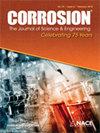氯化物浓度对大气环境中Al-Mg合金环境辅助开裂行为的影响
IF 1.3
4区 材料科学
Q4 MATERIALS SCIENCE, MULTIDISCIPLINARY
引用次数: 0
摘要
采用高保真断裂力学测试和同步电化学电位测量方法,研究了氯化物浓度对大气环境下AA5083-H131环境辅助开裂(EAC)行为的影响。随着氯化物浓度的增加,EAC敏感性在所有环境中都有所增加,表现为阈值应力强度的降低和II期裂纹扩展速率的加快。然而,由于溶液几何效应的阴极限制增加,给定氯浓度下的EAC敏感性在所有氯浓度下都降低了。这些结果在提出的铝镁合金中阳极溶出氢脆机制的背景下进行了分析。具体地说,在较高的氯化物浓度下,EAC敏感性的增加被认为是由于裂纹尖端产生氢的过电位增加。相反,随着溶液几何形状的限制越来越严格,EAC磁化率的下降是由于体表面的阴极限制减少了裂纹尖端的溶解,从而导致裂纹化学活性降低,从而降低了裂纹尖端的产氢和吸收水平。在所有环境和氯化物浓度下,试样表面的开路电位与裂纹扩展动力学之间也存在密切的相关性,较高的氯化物浓度和阴极限制导致较大的电化学电位变化。这与已知的电化学电位依赖性EAC观察结果相吻合。本文章由计算机程序翻译,如有差异,请以英文原文为准。
Effect of chloride concentration on the environment-assisted cracking behavior of an Al-Mg alloy in atmospheric environments
The effect of chloride concentration on the environment-assisted cracking (EAC) behavior of AA5083-H131 in atmospheric environments was investigated using high-fidelity fracture mechanics-based testing and concurrent electrochemical potential measurements. EAC susceptibility was found to increase across all environments as chloride concentration increased, denoted by a decrease in the threshold stress intensity and faster stage II crack growth rates. However, EAC susceptibility for a given chloride concentration decreased across all chloride concentrations as cathodic limitation due to solution geometry effects increased. These results are analyzed in the context of the proposed anodic dissolution-enabled hydrogen embrittlement mechanism for EAC in Al-Mg alloys. Specifically, the increase in EAC susceptibility noted at higher chloride concentrations is postulated to arise from an increased overpotential for hydrogen production at the crack tip. Conversely, the decrease in EAC susceptibility observed as the solution geometry becomes more restrictive is attributed to cathodic limitation at the bulk surface decreasing dissolution at the crack tip, resulting in a concomitant less aggressive crack chemistry, and thus lower levels of hydrogen production and uptake at the crack tip. A close correlation between the open-circuit potential on the bulk specimen surface and the crack growth kinetics was also observed across all environments and chloride concentrations, with higher chloride concentrations and cathodic limitations resulting in larger changes in electrochemical potential. This correlates well with known electrochemical potential-dependent EAC observations for these alloys.
求助全文
通过发布文献求助,成功后即可免费获取论文全文。
去求助
来源期刊

Corrosion
MATERIALS SCIENCE, MULTIDISCIPLINARY-METALLURGY & METALLURGICAL ENGINEERING
CiteScore
2.80
自引率
12.50%
发文量
97
审稿时长
3 months
期刊介绍:
CORROSION is the premier research journal featuring peer-reviewed technical articles from the world’s top researchers and provides a permanent record of progress in the science and technology of corrosion prevention and control. The scope of the journal includes the latest developments in areas of corrosion metallurgy, mechanisms, predictors, cracking (sulfide stress, stress corrosion, hydrogen-induced), passivation, and CO2 corrosion.
70+ years and over 7,100 peer-reviewed articles with advances in corrosion science and engineering have been published in CORROSION. The journal publishes seven article types – original articles, invited critical reviews, technical notes, corrosion communications fast-tracked for rapid publication, special research topic issues, research letters of yearly annual conference student poster sessions, and scientific investigations of field corrosion processes. CORROSION, the Journal of Science and Engineering, serves as an important communication platform for academics, researchers, technical libraries, and universities.
Articles considered for CORROSION should have significant permanent value and should accomplish at least one of the following objectives:
• Contribute awareness of corrosion phenomena,
• Advance understanding of fundamental process, and/or
• Further the knowledge of techniques and practices used to reduce corrosion.
 求助内容:
求助内容: 应助结果提醒方式:
应助结果提醒方式:


